CAMEO Report: Globalisation, Strategy, and Decision Making
VerifiedAdded on 2020/12/09
|14
|4608
|326
Report
AI Summary
This report provides a comprehensive analysis of the impact of globalisation on the energy and chemical enterprise, CAMEO. It begins by examining the factors driving global commerce and trade, including cost, market, environment, and competition. The report then delves into the strategic challenges faced by CAMEO in a global environment, utilizing PESTLE analysis to assess political, economic, social, technological, legal, and environmental factors. It evaluates opportunities and challenges within the global business environment, including the complexities of strategic challenges, risk, and diversification strategies. The report further explores the influences of globalisation on CAMEO's organizational aspects, such as governance, leadership, functions, and culture, utilizing models like McKinsey's 7S. It concludes with an evaluation of decision-making processes in a global context and various routes to internationalization. The report provides critical evaluations and recommendations to overcome barriers in international business.
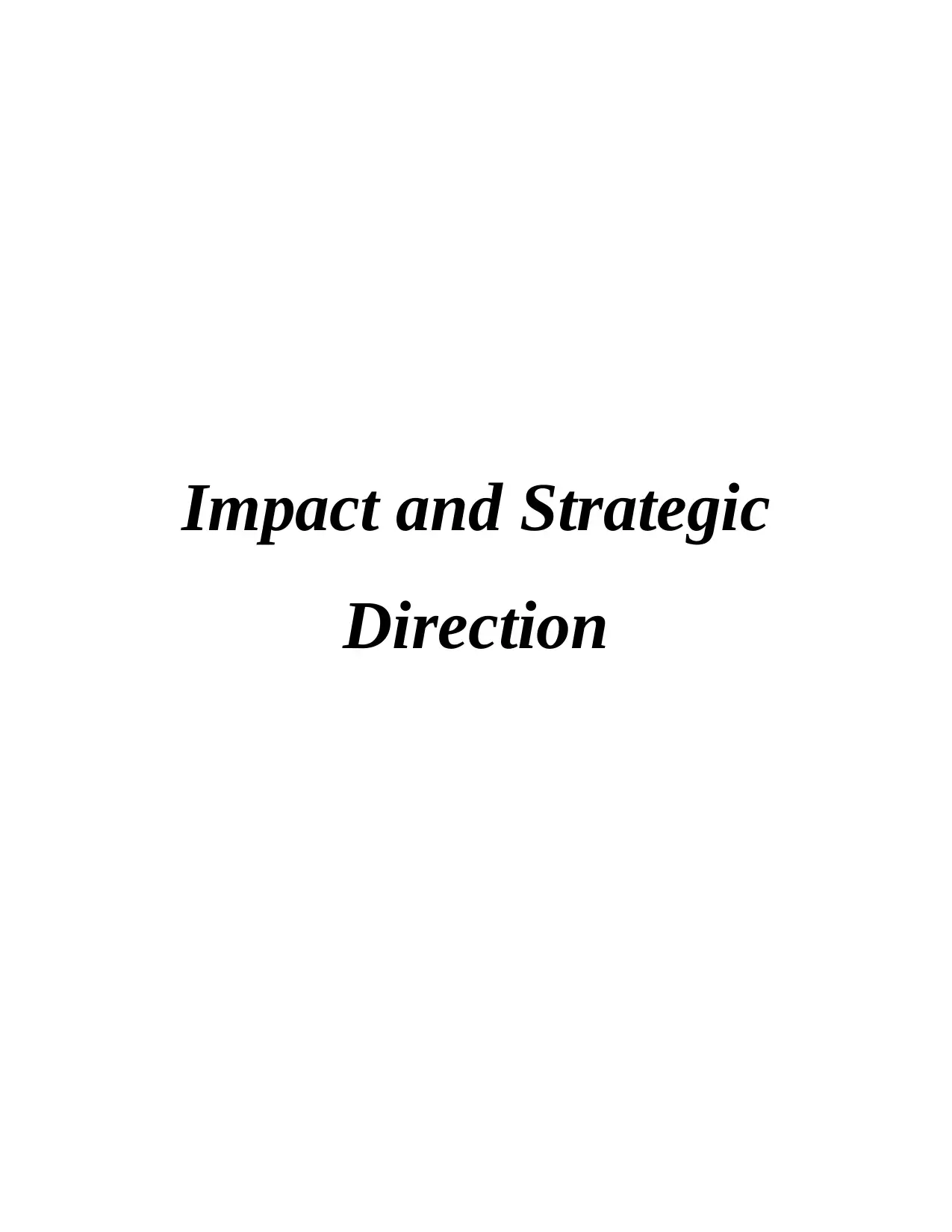
Impact and Strategic
Direction
Direction
Paraphrase This Document
Need a fresh take? Get an instant paraphrase of this document with our AI Paraphraser
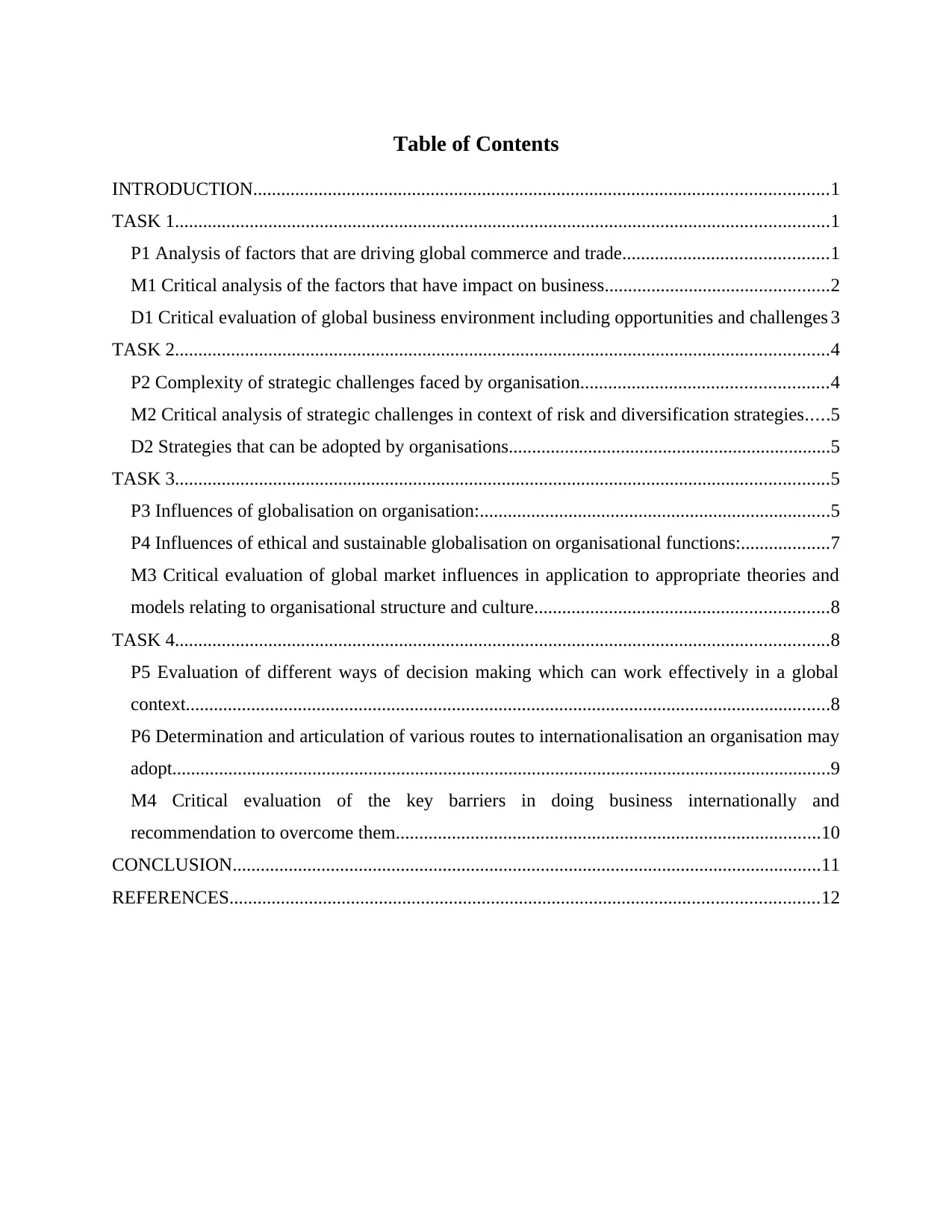
Table of Contents
INTRODUCTION...........................................................................................................................1
TASK 1............................................................................................................................................1
P1 Analysis of factors that are driving global commerce and trade............................................1
M1 Critical analysis of the factors that have impact on business................................................2
D1 Critical evaluation of global business environment including opportunities and challenges 3
TASK 2............................................................................................................................................4
P2 Complexity of strategic challenges faced by organisation.....................................................4
M2 Critical analysis of strategic challenges in context of risk and diversification strategies.....5
D2 Strategies that can be adopted by organisations.....................................................................5
TASK 3............................................................................................................................................5
P3 Influences of globalisation on organisation:...........................................................................5
P4 Influences of ethical and sustainable globalisation on organisational functions:...................7
M3 Critical evaluation of global market influences in application to appropriate theories and
models relating to organisational structure and culture...............................................................8
TASK 4............................................................................................................................................8
P5 Evaluation of different ways of decision making which can work effectively in a global
context..........................................................................................................................................8
P6 Determination and articulation of various routes to internationalisation an organisation may
adopt.............................................................................................................................................9
M4 Critical evaluation of the key barriers in doing business internationally and
recommendation to overcome them...........................................................................................10
CONCLUSION..............................................................................................................................11
REFERENCES..............................................................................................................................12
INTRODUCTION...........................................................................................................................1
TASK 1............................................................................................................................................1
P1 Analysis of factors that are driving global commerce and trade............................................1
M1 Critical analysis of the factors that have impact on business................................................2
D1 Critical evaluation of global business environment including opportunities and challenges 3
TASK 2............................................................................................................................................4
P2 Complexity of strategic challenges faced by organisation.....................................................4
M2 Critical analysis of strategic challenges in context of risk and diversification strategies.....5
D2 Strategies that can be adopted by organisations.....................................................................5
TASK 3............................................................................................................................................5
P3 Influences of globalisation on organisation:...........................................................................5
P4 Influences of ethical and sustainable globalisation on organisational functions:...................7
M3 Critical evaluation of global market influences in application to appropriate theories and
models relating to organisational structure and culture...............................................................8
TASK 4............................................................................................................................................8
P5 Evaluation of different ways of decision making which can work effectively in a global
context..........................................................................................................................................8
P6 Determination and articulation of various routes to internationalisation an organisation may
adopt.............................................................................................................................................9
M4 Critical evaluation of the key barriers in doing business internationally and
recommendation to overcome them...........................................................................................10
CONCLUSION..............................................................................................................................11
REFERENCES..............................................................................................................................12
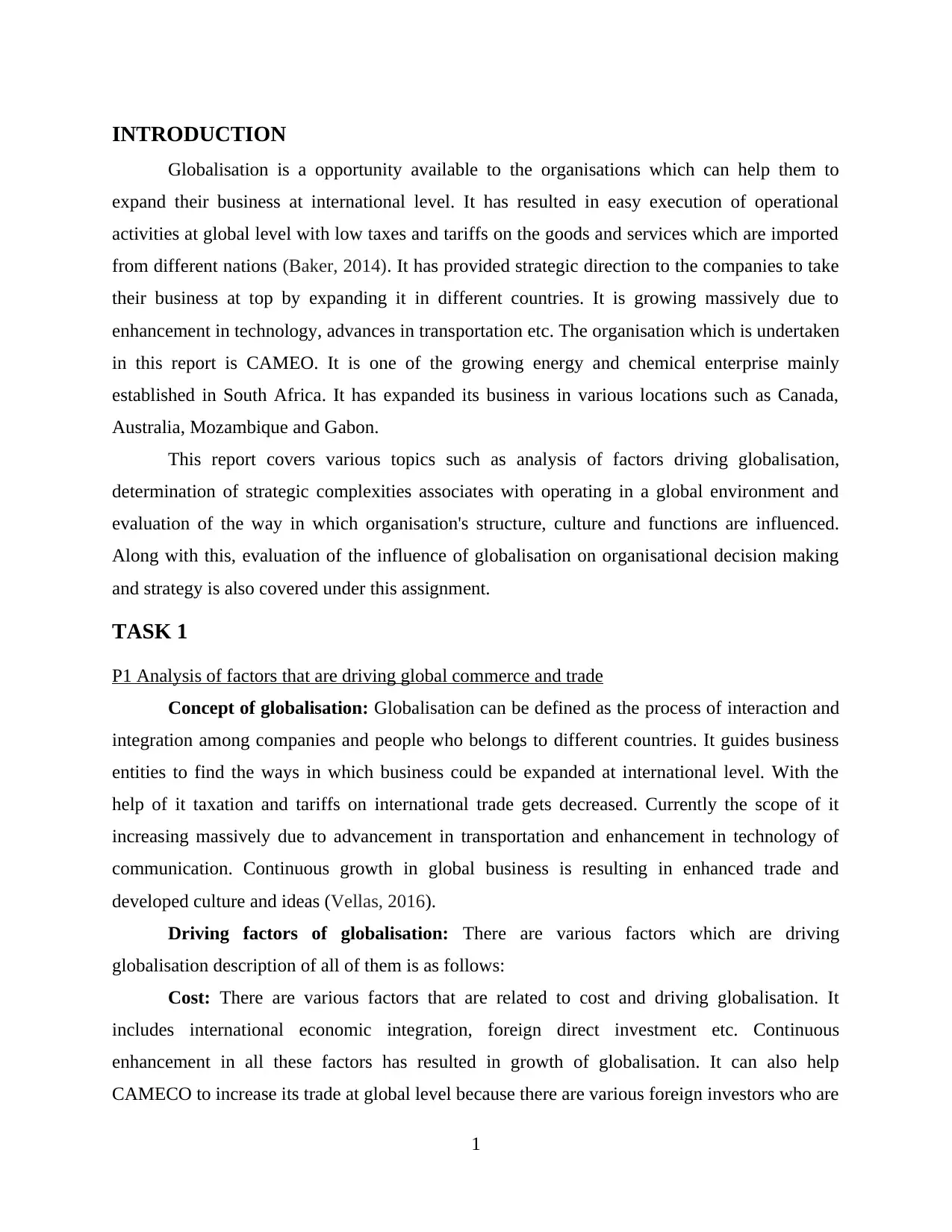
INTRODUCTION
Globalisation is a opportunity available to the organisations which can help them to
expand their business at international level. It has resulted in easy execution of operational
activities at global level with low taxes and tariffs on the goods and services which are imported
from different nations (Baker, 2014). It has provided strategic direction to the companies to take
their business at top by expanding it in different countries. It is growing massively due to
enhancement in technology, advances in transportation etc. The organisation which is undertaken
in this report is CAMEO. It is one of the growing energy and chemical enterprise mainly
established in South Africa. It has expanded its business in various locations such as Canada,
Australia, Mozambique and Gabon.
This report covers various topics such as analysis of factors driving globalisation,
determination of strategic complexities associates with operating in a global environment and
evaluation of the way in which organisation's structure, culture and functions are influenced.
Along with this, evaluation of the influence of globalisation on organisational decision making
and strategy is also covered under this assignment.
TASK 1
P1 Analysis of factors that are driving global commerce and trade
Concept of globalisation: Globalisation can be defined as the process of interaction and
integration among companies and people who belongs to different countries. It guides business
entities to find the ways in which business could be expanded at international level. With the
help of it taxation and tariffs on international trade gets decreased. Currently the scope of it
increasing massively due to advancement in transportation and enhancement in technology of
communication. Continuous growth in global business is resulting in enhanced trade and
developed culture and ideas (Vellas, 2016).
Driving factors of globalisation: There are various factors which are driving
globalisation description of all of them is as follows:
Cost: There are various factors that are related to cost and driving globalisation. It
includes international economic integration, foreign direct investment etc. Continuous
enhancement in all these factors has resulted in growth of globalisation. It can also help
CAMECO to increase its trade at global level because there are various foreign investors who are
1
Globalisation is a opportunity available to the organisations which can help them to
expand their business at international level. It has resulted in easy execution of operational
activities at global level with low taxes and tariffs on the goods and services which are imported
from different nations (Baker, 2014). It has provided strategic direction to the companies to take
their business at top by expanding it in different countries. It is growing massively due to
enhancement in technology, advances in transportation etc. The organisation which is undertaken
in this report is CAMEO. It is one of the growing energy and chemical enterprise mainly
established in South Africa. It has expanded its business in various locations such as Canada,
Australia, Mozambique and Gabon.
This report covers various topics such as analysis of factors driving globalisation,
determination of strategic complexities associates with operating in a global environment and
evaluation of the way in which organisation's structure, culture and functions are influenced.
Along with this, evaluation of the influence of globalisation on organisational decision making
and strategy is also covered under this assignment.
TASK 1
P1 Analysis of factors that are driving global commerce and trade
Concept of globalisation: Globalisation can be defined as the process of interaction and
integration among companies and people who belongs to different countries. It guides business
entities to find the ways in which business could be expanded at international level. With the
help of it taxation and tariffs on international trade gets decreased. Currently the scope of it
increasing massively due to advancement in transportation and enhancement in technology of
communication. Continuous growth in global business is resulting in enhanced trade and
developed culture and ideas (Vellas, 2016).
Driving factors of globalisation: There are various factors which are driving
globalisation description of all of them is as follows:
Cost: There are various factors that are related to cost and driving globalisation. It
includes international economic integration, foreign direct investment etc. Continuous
enhancement in all these factors has resulted in growth of globalisation. It can also help
CAMECO to increase its trade at global level because there are various foreign investors who are
1
⊘ This is a preview!⊘
Do you want full access?
Subscribe today to unlock all pages.

Trusted by 1+ million students worldwide
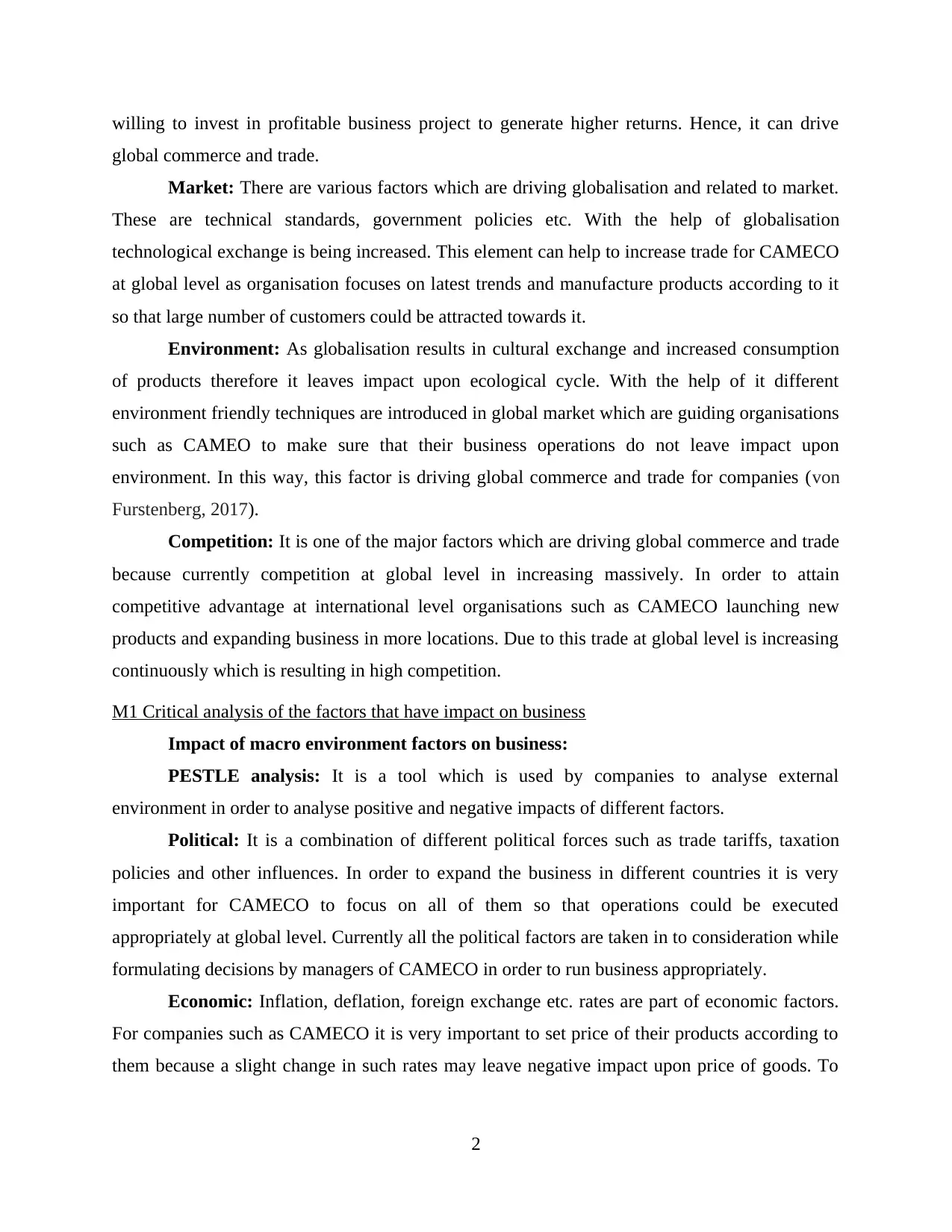
willing to invest in profitable business project to generate higher returns. Hence, it can drive
global commerce and trade.
Market: There are various factors which are driving globalisation and related to market.
These are technical standards, government policies etc. With the help of globalisation
technological exchange is being increased. This element can help to increase trade for CAMECO
at global level as organisation focuses on latest trends and manufacture products according to it
so that large number of customers could be attracted towards it.
Environment: As globalisation results in cultural exchange and increased consumption
of products therefore it leaves impact upon ecological cycle. With the help of it different
environment friendly techniques are introduced in global market which are guiding organisations
such as CAMEO to make sure that their business operations do not leave impact upon
environment. In this way, this factor is driving global commerce and trade for companies (von
Furstenberg, 2017).
Competition: It is one of the major factors which are driving global commerce and trade
because currently competition at global level in increasing massively. In order to attain
competitive advantage at international level organisations such as CAMECO launching new
products and expanding business in more locations. Due to this trade at global level is increasing
continuously which is resulting in high competition.
M1 Critical analysis of the factors that have impact on business
Impact of macro environment factors on business:
PESTLE analysis: It is a tool which is used by companies to analyse external
environment in order to analyse positive and negative impacts of different factors.
Political: It is a combination of different political forces such as trade tariffs, taxation
policies and other influences. In order to expand the business in different countries it is very
important for CAMECO to focus on all of them so that operations could be executed
appropriately at global level. Currently all the political factors are taken in to consideration while
formulating decisions by managers of CAMECO in order to run business appropriately.
Economic: Inflation, deflation, foreign exchange etc. rates are part of economic factors.
For companies such as CAMECO it is very important to set price of their products according to
them because a slight change in such rates may leave negative impact upon price of goods. To
2
global commerce and trade.
Market: There are various factors which are driving globalisation and related to market.
These are technical standards, government policies etc. With the help of globalisation
technological exchange is being increased. This element can help to increase trade for CAMECO
at global level as organisation focuses on latest trends and manufacture products according to it
so that large number of customers could be attracted towards it.
Environment: As globalisation results in cultural exchange and increased consumption
of products therefore it leaves impact upon ecological cycle. With the help of it different
environment friendly techniques are introduced in global market which are guiding organisations
such as CAMEO to make sure that their business operations do not leave impact upon
environment. In this way, this factor is driving global commerce and trade for companies (von
Furstenberg, 2017).
Competition: It is one of the major factors which are driving global commerce and trade
because currently competition at global level in increasing massively. In order to attain
competitive advantage at international level organisations such as CAMECO launching new
products and expanding business in more locations. Due to this trade at global level is increasing
continuously which is resulting in high competition.
M1 Critical analysis of the factors that have impact on business
Impact of macro environment factors on business:
PESTLE analysis: It is a tool which is used by companies to analyse external
environment in order to analyse positive and negative impacts of different factors.
Political: It is a combination of different political forces such as trade tariffs, taxation
policies and other influences. In order to expand the business in different countries it is very
important for CAMECO to focus on all of them so that operations could be executed
appropriately at global level. Currently all the political factors are taken in to consideration while
formulating decisions by managers of CAMECO in order to run business appropriately.
Economic: Inflation, deflation, foreign exchange etc. rates are part of economic factors.
For companies such as CAMECO it is very important to set price of their products according to
them because a slight change in such rates may leave negative impact upon price of goods. To
2
Paraphrase This Document
Need a fresh take? Get an instant paraphrase of this document with our AI Paraphraser
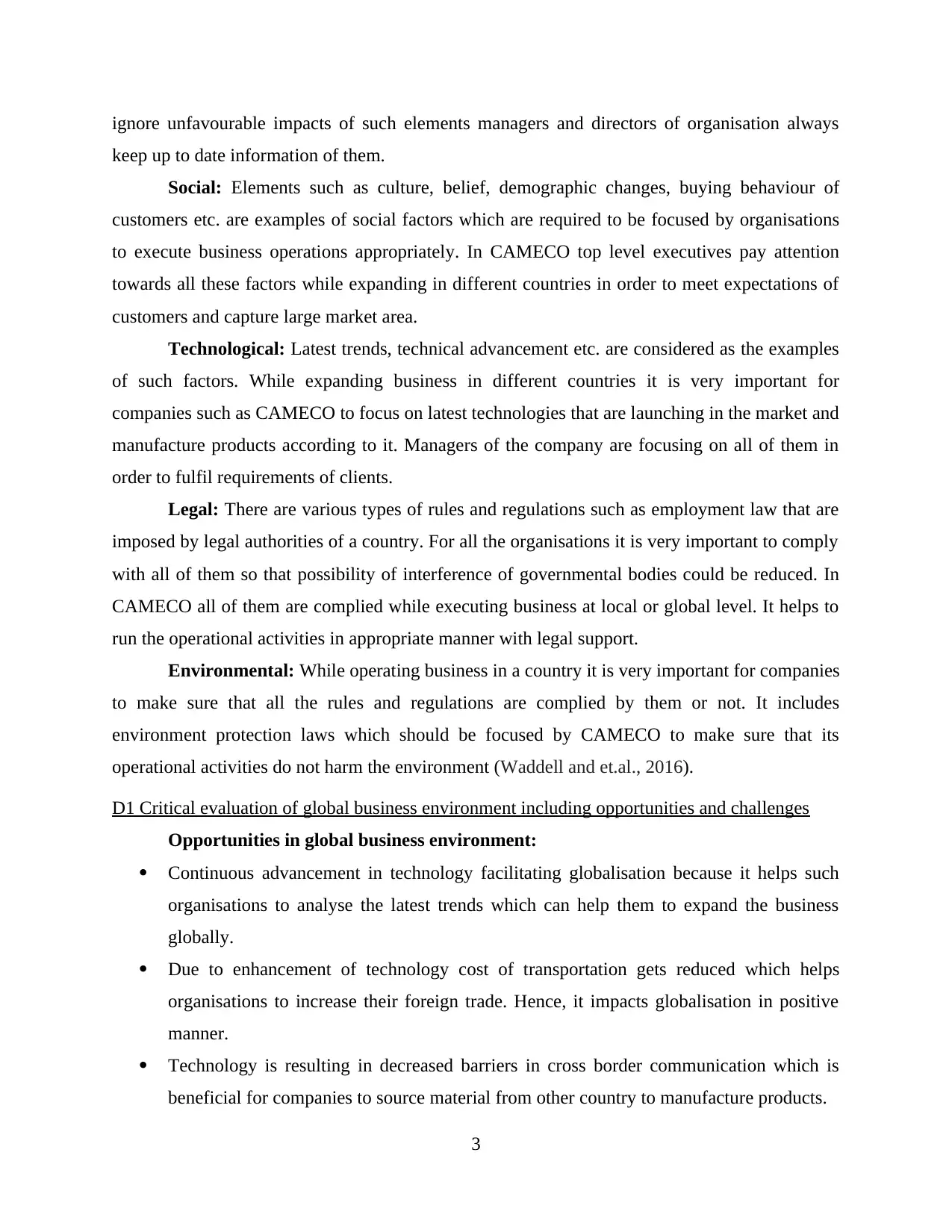
ignore unfavourable impacts of such elements managers and directors of organisation always
keep up to date information of them.
Social: Elements such as culture, belief, demographic changes, buying behaviour of
customers etc. are examples of social factors which are required to be focused by organisations
to execute business operations appropriately. In CAMECO top level executives pay attention
towards all these factors while expanding in different countries in order to meet expectations of
customers and capture large market area.
Technological: Latest trends, technical advancement etc. are considered as the examples
of such factors. While expanding business in different countries it is very important for
companies such as CAMECO to focus on latest technologies that are launching in the market and
manufacture products according to it. Managers of the company are focusing on all of them in
order to fulfil requirements of clients.
Legal: There are various types of rules and regulations such as employment law that are
imposed by legal authorities of a country. For all the organisations it is very important to comply
with all of them so that possibility of interference of governmental bodies could be reduced. In
CAMECO all of them are complied while executing business at local or global level. It helps to
run the operational activities in appropriate manner with legal support.
Environmental: While operating business in a country it is very important for companies
to make sure that all the rules and regulations are complied by them or not. It includes
environment protection laws which should be focused by CAMECO to make sure that its
operational activities do not harm the environment (Waddell and et.al., 2016).
D1 Critical evaluation of global business environment including opportunities and challenges
Opportunities in global business environment:
Continuous advancement in technology facilitating globalisation because it helps such
organisations to analyse the latest trends which can help them to expand the business
globally.
Due to enhancement of technology cost of transportation gets reduced which helps
organisations to increase their foreign trade. Hence, it impacts globalisation in positive
manner.
Technology is resulting in decreased barriers in cross border communication which is
beneficial for companies to source material from other country to manufacture products.
3
keep up to date information of them.
Social: Elements such as culture, belief, demographic changes, buying behaviour of
customers etc. are examples of social factors which are required to be focused by organisations
to execute business operations appropriately. In CAMECO top level executives pay attention
towards all these factors while expanding in different countries in order to meet expectations of
customers and capture large market area.
Technological: Latest trends, technical advancement etc. are considered as the examples
of such factors. While expanding business in different countries it is very important for
companies such as CAMECO to focus on latest technologies that are launching in the market and
manufacture products according to it. Managers of the company are focusing on all of them in
order to fulfil requirements of clients.
Legal: There are various types of rules and regulations such as employment law that are
imposed by legal authorities of a country. For all the organisations it is very important to comply
with all of them so that possibility of interference of governmental bodies could be reduced. In
CAMECO all of them are complied while executing business at local or global level. It helps to
run the operational activities in appropriate manner with legal support.
Environmental: While operating business in a country it is very important for companies
to make sure that all the rules and regulations are complied by them or not. It includes
environment protection laws which should be focused by CAMECO to make sure that its
operational activities do not harm the environment (Waddell and et.al., 2016).
D1 Critical evaluation of global business environment including opportunities and challenges
Opportunities in global business environment:
Continuous advancement in technology facilitating globalisation because it helps such
organisations to analyse the latest trends which can help them to expand the business
globally.
Due to enhancement of technology cost of transportation gets reduced which helps
organisations to increase their foreign trade. Hence, it impacts globalisation in positive
manner.
Technology is resulting in decreased barriers in cross border communication which is
beneficial for companies to source material from other country to manufacture products.
3
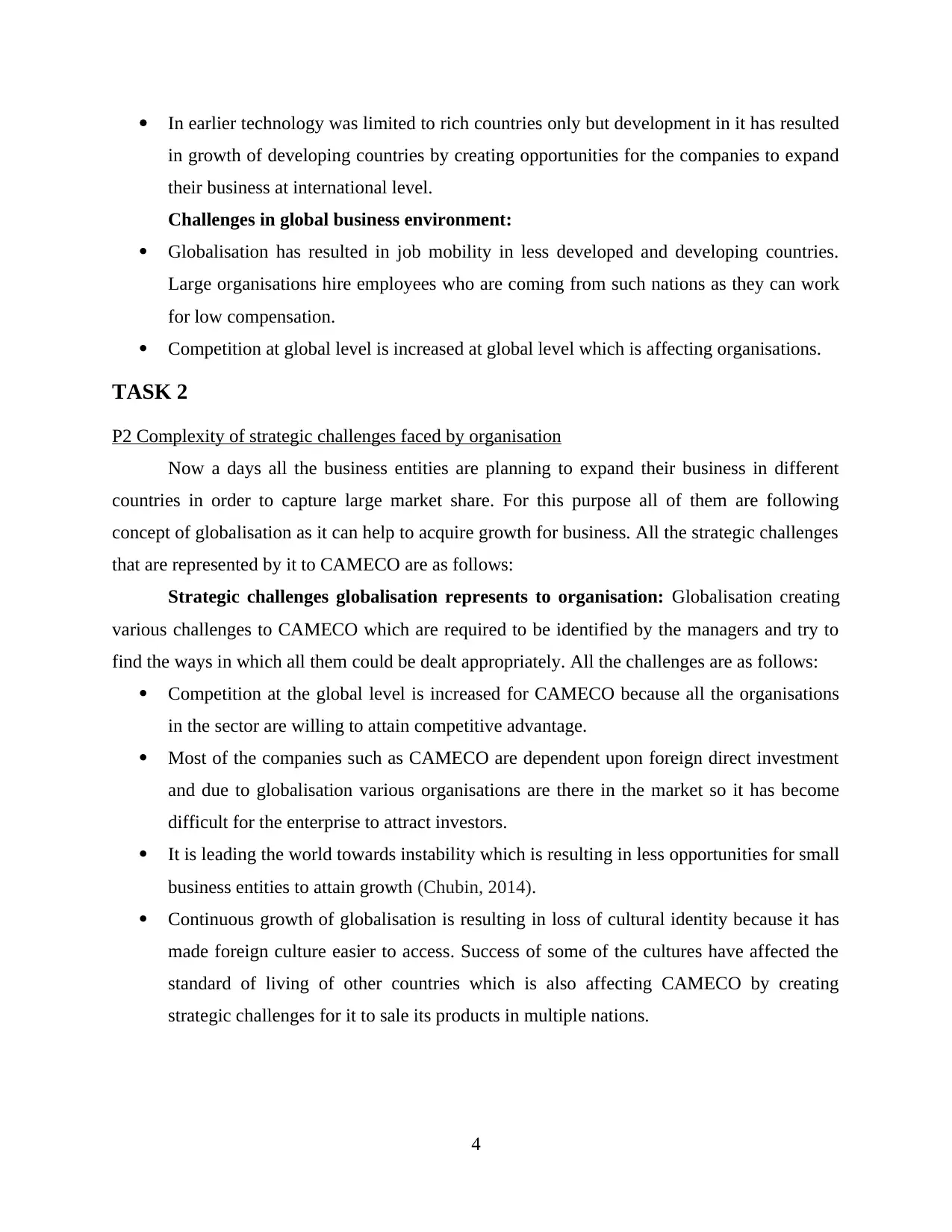
In earlier technology was limited to rich countries only but development in it has resulted
in growth of developing countries by creating opportunities for the companies to expand
their business at international level.
Challenges in global business environment:
Globalisation has resulted in job mobility in less developed and developing countries.
Large organisations hire employees who are coming from such nations as they can work
for low compensation.
Competition at global level is increased at global level which is affecting organisations.
TASK 2
P2 Complexity of strategic challenges faced by organisation
Now a days all the business entities are planning to expand their business in different
countries in order to capture large market share. For this purpose all of them are following
concept of globalisation as it can help to acquire growth for business. All the strategic challenges
that are represented by it to CAMECO are as follows:
Strategic challenges globalisation represents to organisation: Globalisation creating
various challenges to CAMECO which are required to be identified by the managers and try to
find the ways in which all them could be dealt appropriately. All the challenges are as follows:
Competition at the global level is increased for CAMECO because all the organisations
in the sector are willing to attain competitive advantage.
Most of the companies such as CAMECO are dependent upon foreign direct investment
and due to globalisation various organisations are there in the market so it has become
difficult for the enterprise to attract investors.
It is leading the world towards instability which is resulting in less opportunities for small
business entities to attain growth (Chubin, 2014).
Continuous growth of globalisation is resulting in loss of cultural identity because it has
made foreign culture easier to access. Success of some of the cultures have affected the
standard of living of other countries which is also affecting CAMECO by creating
strategic challenges for it to sale its products in multiple nations.
4
in growth of developing countries by creating opportunities for the companies to expand
their business at international level.
Challenges in global business environment:
Globalisation has resulted in job mobility in less developed and developing countries.
Large organisations hire employees who are coming from such nations as they can work
for low compensation.
Competition at global level is increased at global level which is affecting organisations.
TASK 2
P2 Complexity of strategic challenges faced by organisation
Now a days all the business entities are planning to expand their business in different
countries in order to capture large market share. For this purpose all of them are following
concept of globalisation as it can help to acquire growth for business. All the strategic challenges
that are represented by it to CAMECO are as follows:
Strategic challenges globalisation represents to organisation: Globalisation creating
various challenges to CAMECO which are required to be identified by the managers and try to
find the ways in which all them could be dealt appropriately. All the challenges are as follows:
Competition at the global level is increased for CAMECO because all the organisations
in the sector are willing to attain competitive advantage.
Most of the companies such as CAMECO are dependent upon foreign direct investment
and due to globalisation various organisations are there in the market so it has become
difficult for the enterprise to attract investors.
It is leading the world towards instability which is resulting in less opportunities for small
business entities to attain growth (Chubin, 2014).
Continuous growth of globalisation is resulting in loss of cultural identity because it has
made foreign culture easier to access. Success of some of the cultures have affected the
standard of living of other countries which is also affecting CAMECO by creating
strategic challenges for it to sale its products in multiple nations.
4
⊘ This is a preview!⊘
Do you want full access?
Subscribe today to unlock all pages.

Trusted by 1+ million students worldwide
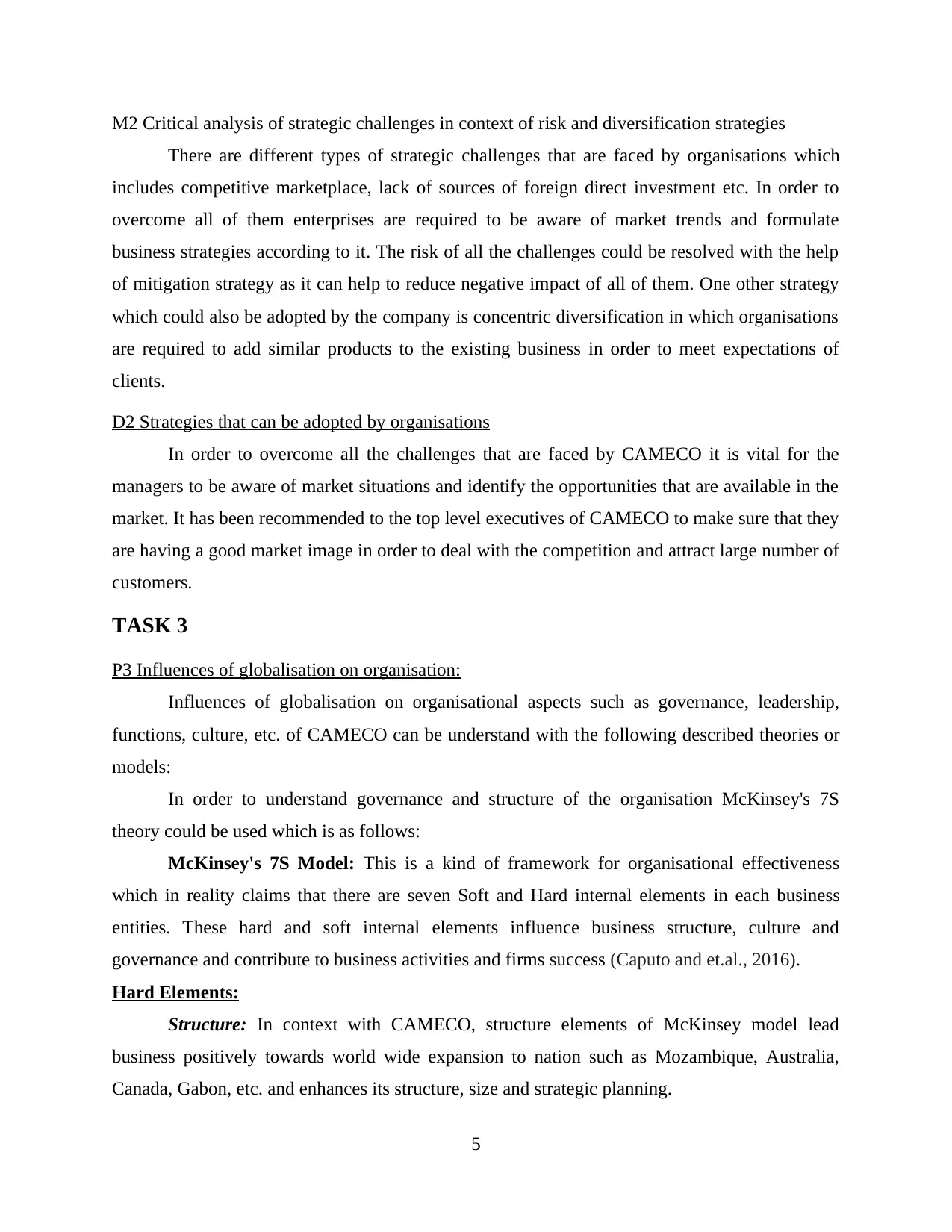
M2 Critical analysis of strategic challenges in context of risk and diversification strategies
There are different types of strategic challenges that are faced by organisations which
includes competitive marketplace, lack of sources of foreign direct investment etc. In order to
overcome all of them enterprises are required to be aware of market trends and formulate
business strategies according to it. The risk of all the challenges could be resolved with the help
of mitigation strategy as it can help to reduce negative impact of all of them. One other strategy
which could also be adopted by the company is concentric diversification in which organisations
are required to add similar products to the existing business in order to meet expectations of
clients.
D2 Strategies that can be adopted by organisations
In order to overcome all the challenges that are faced by CAMECO it is vital for the
managers to be aware of market situations and identify the opportunities that are available in the
market. It has been recommended to the top level executives of CAMECO to make sure that they
are having a good market image in order to deal with the competition and attract large number of
customers.
TASK 3
P3 Influences of globalisation on organisation:
Influences of globalisation on organisational aspects such as governance, leadership,
functions, culture, etc. of CAMECO can be understand with the following described theories or
models:
In order to understand governance and structure of the organisation McKinsey's 7S
theory could be used which is as follows:
McKinsey's 7S Model: This is a kind of framework for organisational effectiveness
which in reality claims that there are seven Soft and Hard internal elements in each business
entities. These hard and soft internal elements influence business structure, culture and
governance and contribute to business activities and firms success (Caputo and et.al., 2016).
Hard Elements:
Structure: In context with CAMECO, structure elements of McKinsey model lead
business positively towards world wide expansion to nation such as Mozambique, Australia,
Canada, Gabon, etc. and enhances its structure, size and strategic planning.
5
There are different types of strategic challenges that are faced by organisations which
includes competitive marketplace, lack of sources of foreign direct investment etc. In order to
overcome all of them enterprises are required to be aware of market trends and formulate
business strategies according to it. The risk of all the challenges could be resolved with the help
of mitigation strategy as it can help to reduce negative impact of all of them. One other strategy
which could also be adopted by the company is concentric diversification in which organisations
are required to add similar products to the existing business in order to meet expectations of
clients.
D2 Strategies that can be adopted by organisations
In order to overcome all the challenges that are faced by CAMECO it is vital for the
managers to be aware of market situations and identify the opportunities that are available in the
market. It has been recommended to the top level executives of CAMECO to make sure that they
are having a good market image in order to deal with the competition and attract large number of
customers.
TASK 3
P3 Influences of globalisation on organisation:
Influences of globalisation on organisational aspects such as governance, leadership,
functions, culture, etc. of CAMECO can be understand with the following described theories or
models:
In order to understand governance and structure of the organisation McKinsey's 7S
theory could be used which is as follows:
McKinsey's 7S Model: This is a kind of framework for organisational effectiveness
which in reality claims that there are seven Soft and Hard internal elements in each business
entities. These hard and soft internal elements influence business structure, culture and
governance and contribute to business activities and firms success (Caputo and et.al., 2016).
Hard Elements:
Structure: In context with CAMECO, structure elements of McKinsey model lead
business positively towards world wide expansion to nation such as Mozambique, Australia,
Canada, Gabon, etc. and enhances its structure, size and strategic planning.
5
Paraphrase This Document
Need a fresh take? Get an instant paraphrase of this document with our AI Paraphraser
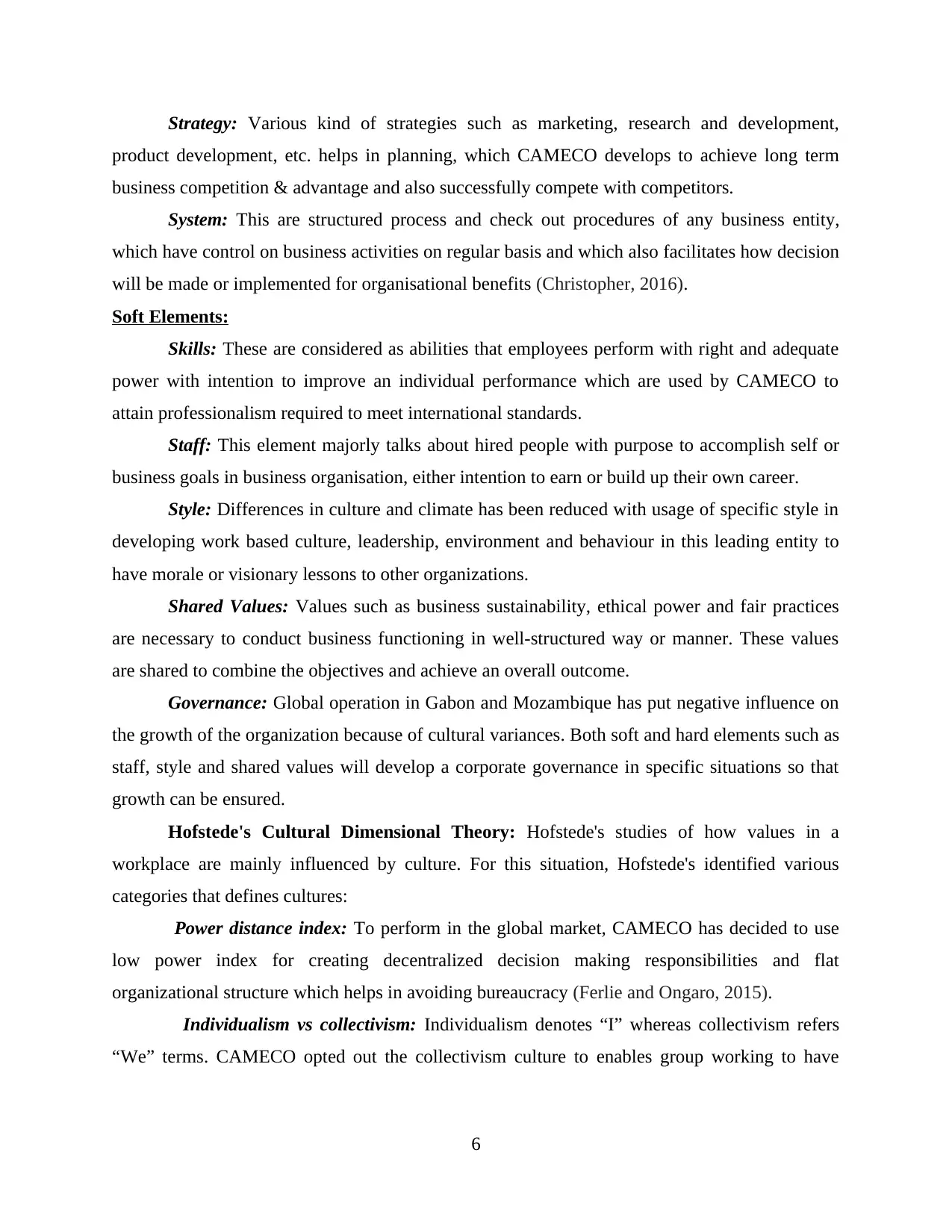
Strategy: Various kind of strategies such as marketing, research and development,
product development, etc. helps in planning, which CAMECO develops to achieve long term
business competition & advantage and also successfully compete with competitors.
System: This are structured process and check out procedures of any business entity,
which have control on business activities on regular basis and which also facilitates how decision
will be made or implemented for organisational benefits (Christopher, 2016).
Soft Elements:
Skills: These are considered as abilities that employees perform with right and adequate
power with intention to improve an individual performance which are used by CAMECO to
attain professionalism required to meet international standards.
Staff: This element majorly talks about hired people with purpose to accomplish self or
business goals in business organisation, either intention to earn or build up their own career.
Style: Differences in culture and climate has been reduced with usage of specific style in
developing work based culture, leadership, environment and behaviour in this leading entity to
have morale or visionary lessons to other organizations.
Shared Values: Values such as business sustainability, ethical power and fair practices
are necessary to conduct business functioning in well-structured way or manner. These values
are shared to combine the objectives and achieve an overall outcome.
Governance: Global operation in Gabon and Mozambique has put negative influence on
the growth of the organization because of cultural variances. Both soft and hard elements such as
staff, style and shared values will develop a corporate governance in specific situations so that
growth can be ensured.
Hofstede's Cultural Dimensional Theory: Hofstede's studies of how values in a
workplace are mainly influenced by culture. For this situation, Hofstede's identified various
categories that defines cultures:
Power distance index: To perform in the global market, CAMECO has decided to use
low power index for creating decentralized decision making responsibilities and flat
organizational structure which helps in avoiding bureaucracy (Ferlie and Ongaro, 2015).
Individualism vs collectivism: Individualism denotes “I” whereas collectivism refers
“We” terms. CAMECO opted out the collectivism culture to enables group working to have
6
product development, etc. helps in planning, which CAMECO develops to achieve long term
business competition & advantage and also successfully compete with competitors.
System: This are structured process and check out procedures of any business entity,
which have control on business activities on regular basis and which also facilitates how decision
will be made or implemented for organisational benefits (Christopher, 2016).
Soft Elements:
Skills: These are considered as abilities that employees perform with right and adequate
power with intention to improve an individual performance which are used by CAMECO to
attain professionalism required to meet international standards.
Staff: This element majorly talks about hired people with purpose to accomplish self or
business goals in business organisation, either intention to earn or build up their own career.
Style: Differences in culture and climate has been reduced with usage of specific style in
developing work based culture, leadership, environment and behaviour in this leading entity to
have morale or visionary lessons to other organizations.
Shared Values: Values such as business sustainability, ethical power and fair practices
are necessary to conduct business functioning in well-structured way or manner. These values
are shared to combine the objectives and achieve an overall outcome.
Governance: Global operation in Gabon and Mozambique has put negative influence on
the growth of the organization because of cultural variances. Both soft and hard elements such as
staff, style and shared values will develop a corporate governance in specific situations so that
growth can be ensured.
Hofstede's Cultural Dimensional Theory: Hofstede's studies of how values in a
workplace are mainly influenced by culture. For this situation, Hofstede's identified various
categories that defines cultures:
Power distance index: To perform in the global market, CAMECO has decided to use
low power index for creating decentralized decision making responsibilities and flat
organizational structure which helps in avoiding bureaucracy (Ferlie and Ongaro, 2015).
Individualism vs collectivism: Individualism denotes “I” whereas collectivism refers
“We” terms. CAMECO opted out the collectivism culture to enables group working to have
6
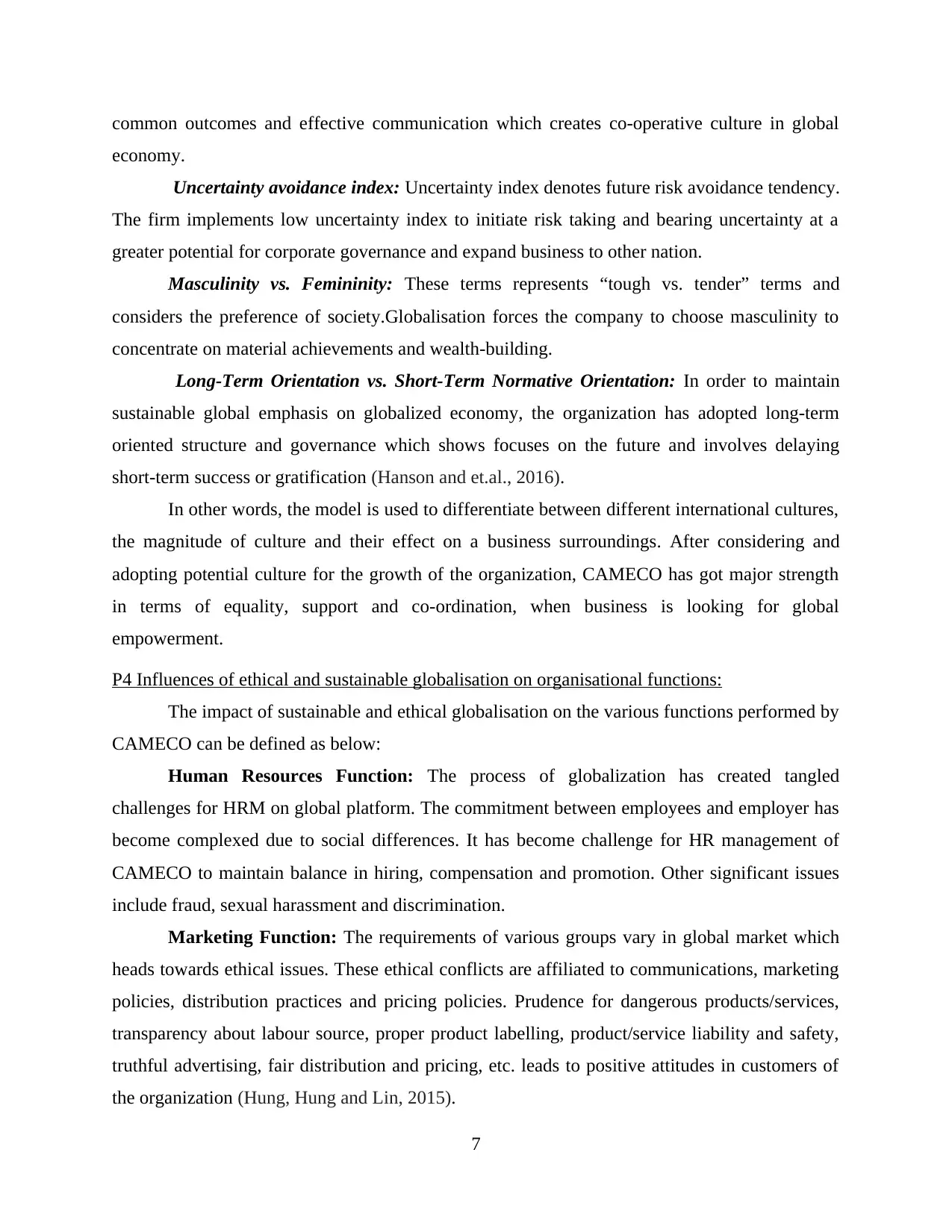
common outcomes and effective communication which creates co-operative culture in global
economy.
Uncertainty avoidance index: Uncertainty index denotes future risk avoidance tendency.
The firm implements low uncertainty index to initiate risk taking and bearing uncertainty at a
greater potential for corporate governance and expand business to other nation.
Masculinity vs. Femininity: These terms represents “tough vs. tender” terms and
considers the preference of society.Globalisation forces the company to choose masculinity to
concentrate on material achievements and wealth-building.
Long-Term Orientation vs. Short-Term Normative Orientation: In order to maintain
sustainable global emphasis on globalized economy, the organization has adopted long-term
oriented structure and governance which shows focuses on the future and involves delaying
short-term success or gratification (Hanson and et.al., 2016).
In other words, the model is used to differentiate between different international cultures,
the magnitude of culture and their effect on a business surroundings. After considering and
adopting potential culture for the growth of the organization, CAMECO has got major strength
in terms of equality, support and co-ordination, when business is looking for global
empowerment.
P4 Influences of ethical and sustainable globalisation on organisational functions:
The impact of sustainable and ethical globalisation on the various functions performed by
CAMECO can be defined as below:
Human Resources Function: The process of globalization has created tangled
challenges for HRM on global platform. The commitment between employees and employer has
become complexed due to social differences. It has become challenge for HR management of
CAMECO to maintain balance in hiring, compensation and promotion. Other significant issues
include fraud, sexual harassment and discrimination.
Marketing Function: The requirements of various groups vary in global market which
heads towards ethical issues. These ethical conflicts are affiliated to communications, marketing
policies, distribution practices and pricing policies. Prudence for dangerous products/services,
transparency about labour source, proper product labelling, product/service liability and safety,
truthful advertising, fair distribution and pricing, etc. leads to positive attitudes in customers of
the organization (Hung, Hung and Lin, 2015).
7
economy.
Uncertainty avoidance index: Uncertainty index denotes future risk avoidance tendency.
The firm implements low uncertainty index to initiate risk taking and bearing uncertainty at a
greater potential for corporate governance and expand business to other nation.
Masculinity vs. Femininity: These terms represents “tough vs. tender” terms and
considers the preference of society.Globalisation forces the company to choose masculinity to
concentrate on material achievements and wealth-building.
Long-Term Orientation vs. Short-Term Normative Orientation: In order to maintain
sustainable global emphasis on globalized economy, the organization has adopted long-term
oriented structure and governance which shows focuses on the future and involves delaying
short-term success or gratification (Hanson and et.al., 2016).
In other words, the model is used to differentiate between different international cultures,
the magnitude of culture and their effect on a business surroundings. After considering and
adopting potential culture for the growth of the organization, CAMECO has got major strength
in terms of equality, support and co-ordination, when business is looking for global
empowerment.
P4 Influences of ethical and sustainable globalisation on organisational functions:
The impact of sustainable and ethical globalisation on the various functions performed by
CAMECO can be defined as below:
Human Resources Function: The process of globalization has created tangled
challenges for HRM on global platform. The commitment between employees and employer has
become complexed due to social differences. It has become challenge for HR management of
CAMECO to maintain balance in hiring, compensation and promotion. Other significant issues
include fraud, sexual harassment and discrimination.
Marketing Function: The requirements of various groups vary in global market which
heads towards ethical issues. These ethical conflicts are affiliated to communications, marketing
policies, distribution practices and pricing policies. Prudence for dangerous products/services,
transparency about labour source, proper product labelling, product/service liability and safety,
truthful advertising, fair distribution and pricing, etc. leads to positive attitudes in customers of
the organization (Hung, Hung and Lin, 2015).
7
⊘ This is a preview!⊘
Do you want full access?
Subscribe today to unlock all pages.

Trusted by 1+ million students worldwide
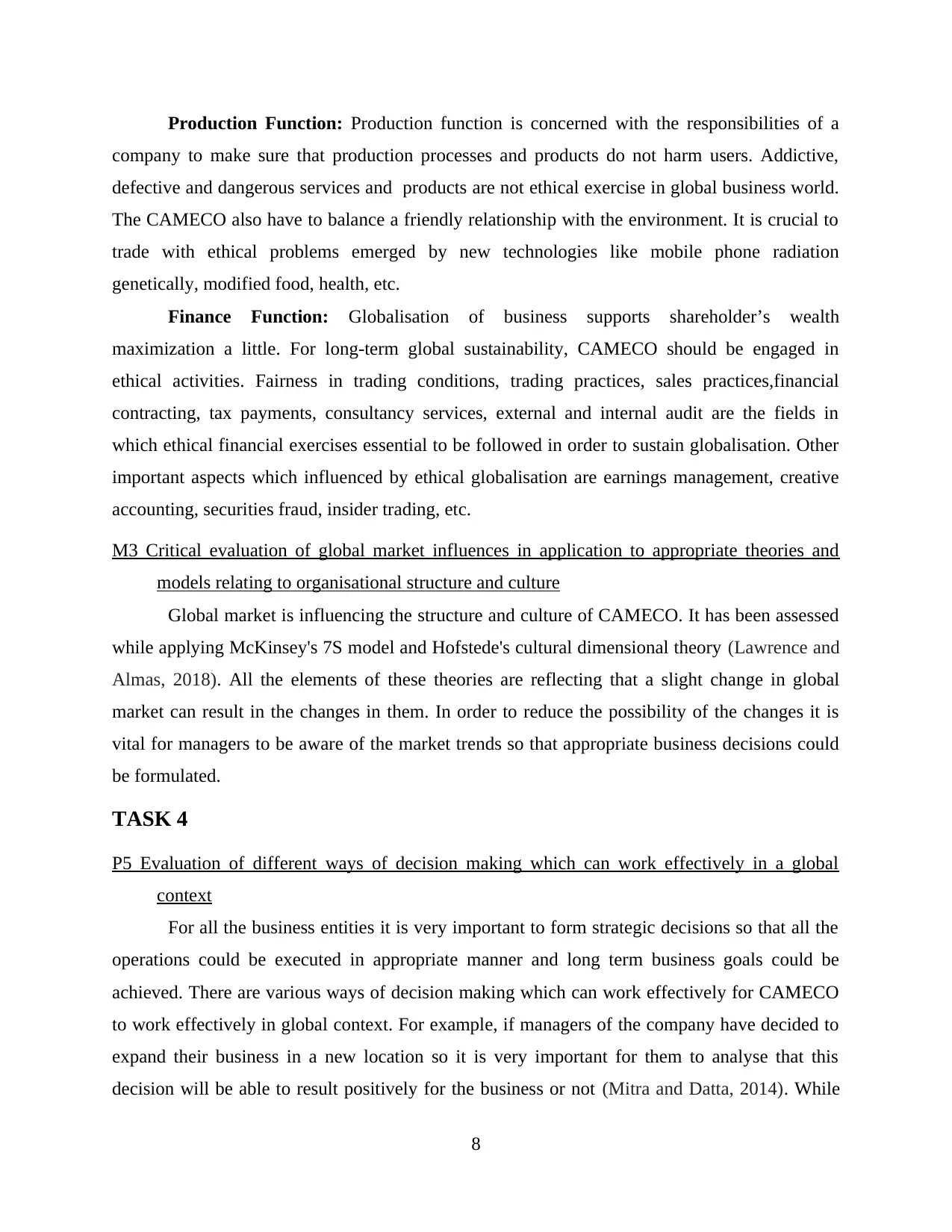
Production Function: Production function is concerned with the responsibilities of a
company to make sure that production processes and products do not harm users. Addictive,
defective and dangerous services and products are not ethical exercise in global business world.
The CAMECO also have to balance a friendly relationship with the environment. It is crucial to
trade with ethical problems emerged by new technologies like mobile phone radiation
genetically, modified food, health, etc.
Finance Function: Globalisation of business supports shareholder’s wealth
maximization a little. For long-term global sustainability, CAMECO should be engaged in
ethical activities. Fairness in trading conditions, trading practices, sales practices,financial
contracting, tax payments, consultancy services, external and internal audit are the fields in
which ethical financial exercises essential to be followed in order to sustain globalisation. Other
important aspects which influenced by ethical globalisation are earnings management, creative
accounting, securities fraud, insider trading, etc.
M3 Critical evaluation of global market influences in application to appropriate theories and
models relating to organisational structure and culture
Global market is influencing the structure and culture of CAMECO. It has been assessed
while applying McKinsey's 7S model and Hofstede's cultural dimensional theory (Lawrence and
Almas, 2018). All the elements of these theories are reflecting that a slight change in global
market can result in the changes in them. In order to reduce the possibility of the changes it is
vital for managers to be aware of the market trends so that appropriate business decisions could
be formulated.
TASK 4
P5 Evaluation of different ways of decision making which can work effectively in a global
context
For all the business entities it is very important to form strategic decisions so that all the
operations could be executed in appropriate manner and long term business goals could be
achieved. There are various ways of decision making which can work effectively for CAMECO
to work effectively in global context. For example, if managers of the company have decided to
expand their business in a new location so it is very important for them to analyse that this
decision will be able to result positively for the business or not (Mitra and Datta, 2014). While
8
company to make sure that production processes and products do not harm users. Addictive,
defective and dangerous services and products are not ethical exercise in global business world.
The CAMECO also have to balance a friendly relationship with the environment. It is crucial to
trade with ethical problems emerged by new technologies like mobile phone radiation
genetically, modified food, health, etc.
Finance Function: Globalisation of business supports shareholder’s wealth
maximization a little. For long-term global sustainability, CAMECO should be engaged in
ethical activities. Fairness in trading conditions, trading practices, sales practices,financial
contracting, tax payments, consultancy services, external and internal audit are the fields in
which ethical financial exercises essential to be followed in order to sustain globalisation. Other
important aspects which influenced by ethical globalisation are earnings management, creative
accounting, securities fraud, insider trading, etc.
M3 Critical evaluation of global market influences in application to appropriate theories and
models relating to organisational structure and culture
Global market is influencing the structure and culture of CAMECO. It has been assessed
while applying McKinsey's 7S model and Hofstede's cultural dimensional theory (Lawrence and
Almas, 2018). All the elements of these theories are reflecting that a slight change in global
market can result in the changes in them. In order to reduce the possibility of the changes it is
vital for managers to be aware of the market trends so that appropriate business decisions could
be formulated.
TASK 4
P5 Evaluation of different ways of decision making which can work effectively in a global
context
For all the business entities it is very important to form strategic decisions so that all the
operations could be executed in appropriate manner and long term business goals could be
achieved. There are various ways of decision making which can work effectively for CAMECO
to work effectively in global context. For example, if managers of the company have decided to
expand their business in a new location so it is very important for them to analyse that this
decision will be able to result positively for the business or not (Mitra and Datta, 2014). While
8
Paraphrase This Document
Need a fresh take? Get an instant paraphrase of this document with our AI Paraphraser
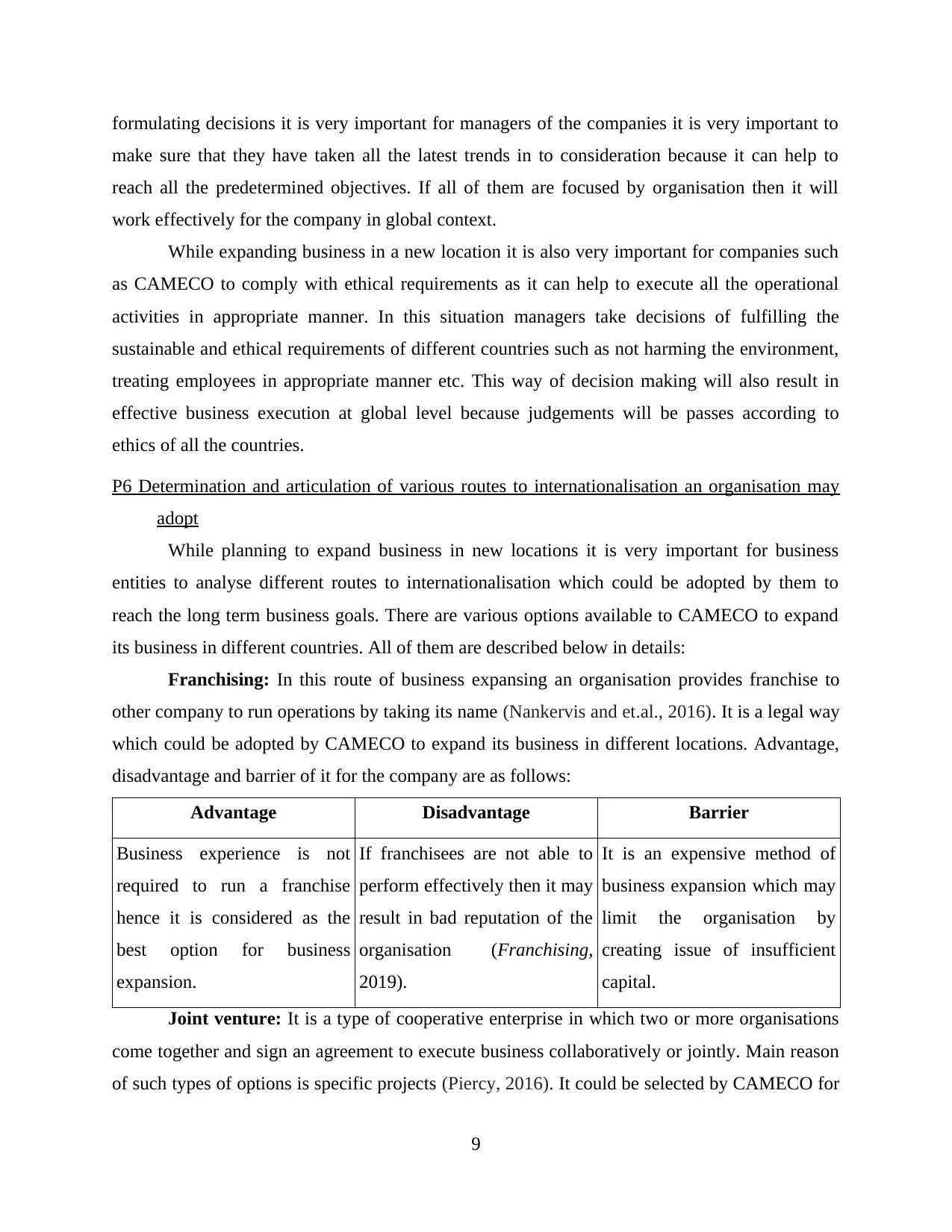
formulating decisions it is very important for managers of the companies it is very important to
make sure that they have taken all the latest trends in to consideration because it can help to
reach all the predetermined objectives. If all of them are focused by organisation then it will
work effectively for the company in global context.
While expanding business in a new location it is also very important for companies such
as CAMECO to comply with ethical requirements as it can help to execute all the operational
activities in appropriate manner. In this situation managers take decisions of fulfilling the
sustainable and ethical requirements of different countries such as not harming the environment,
treating employees in appropriate manner etc. This way of decision making will also result in
effective business execution at global level because judgements will be passes according to
ethics of all the countries.
P6 Determination and articulation of various routes to internationalisation an organisation may
adopt
While planning to expand business in new locations it is very important for business
entities to analyse different routes to internationalisation which could be adopted by them to
reach the long term business goals. There are various options available to CAMECO to expand
its business in different countries. All of them are described below in details:
Franchising: In this route of business expansing an organisation provides franchise to
other company to run operations by taking its name (Nankervis and et.al., 2016). It is a legal way
which could be adopted by CAMECO to expand its business in different locations. Advantage,
disadvantage and barrier of it for the company are as follows:
Advantage Disadvantage Barrier
Business experience is not
required to run a franchise
hence it is considered as the
best option for business
expansion.
If franchisees are not able to
perform effectively then it may
result in bad reputation of the
organisation (Franchising,
2019).
It is an expensive method of
business expansion which may
limit the organisation by
creating issue of insufficient
capital.
Joint venture: It is a type of cooperative enterprise in which two or more organisations
come together and sign an agreement to execute business collaboratively or jointly. Main reason
of such types of options is specific projects (Piercy, 2016). It could be selected by CAMECO for
9
make sure that they have taken all the latest trends in to consideration because it can help to
reach all the predetermined objectives. If all of them are focused by organisation then it will
work effectively for the company in global context.
While expanding business in a new location it is also very important for companies such
as CAMECO to comply with ethical requirements as it can help to execute all the operational
activities in appropriate manner. In this situation managers take decisions of fulfilling the
sustainable and ethical requirements of different countries such as not harming the environment,
treating employees in appropriate manner etc. This way of decision making will also result in
effective business execution at global level because judgements will be passes according to
ethics of all the countries.
P6 Determination and articulation of various routes to internationalisation an organisation may
adopt
While planning to expand business in new locations it is very important for business
entities to analyse different routes to internationalisation which could be adopted by them to
reach the long term business goals. There are various options available to CAMECO to expand
its business in different countries. All of them are described below in details:
Franchising: In this route of business expansing an organisation provides franchise to
other company to run operations by taking its name (Nankervis and et.al., 2016). It is a legal way
which could be adopted by CAMECO to expand its business in different locations. Advantage,
disadvantage and barrier of it for the company are as follows:
Advantage Disadvantage Barrier
Business experience is not
required to run a franchise
hence it is considered as the
best option for business
expansion.
If franchisees are not able to
perform effectively then it may
result in bad reputation of the
organisation (Franchising,
2019).
It is an expensive method of
business expansion which may
limit the organisation by
creating issue of insufficient
capital.
Joint venture: It is a type of cooperative enterprise in which two or more organisations
come together and sign an agreement to execute business collaboratively or jointly. Main reason
of such types of options is specific projects (Piercy, 2016). It could be selected by CAMECO for
9
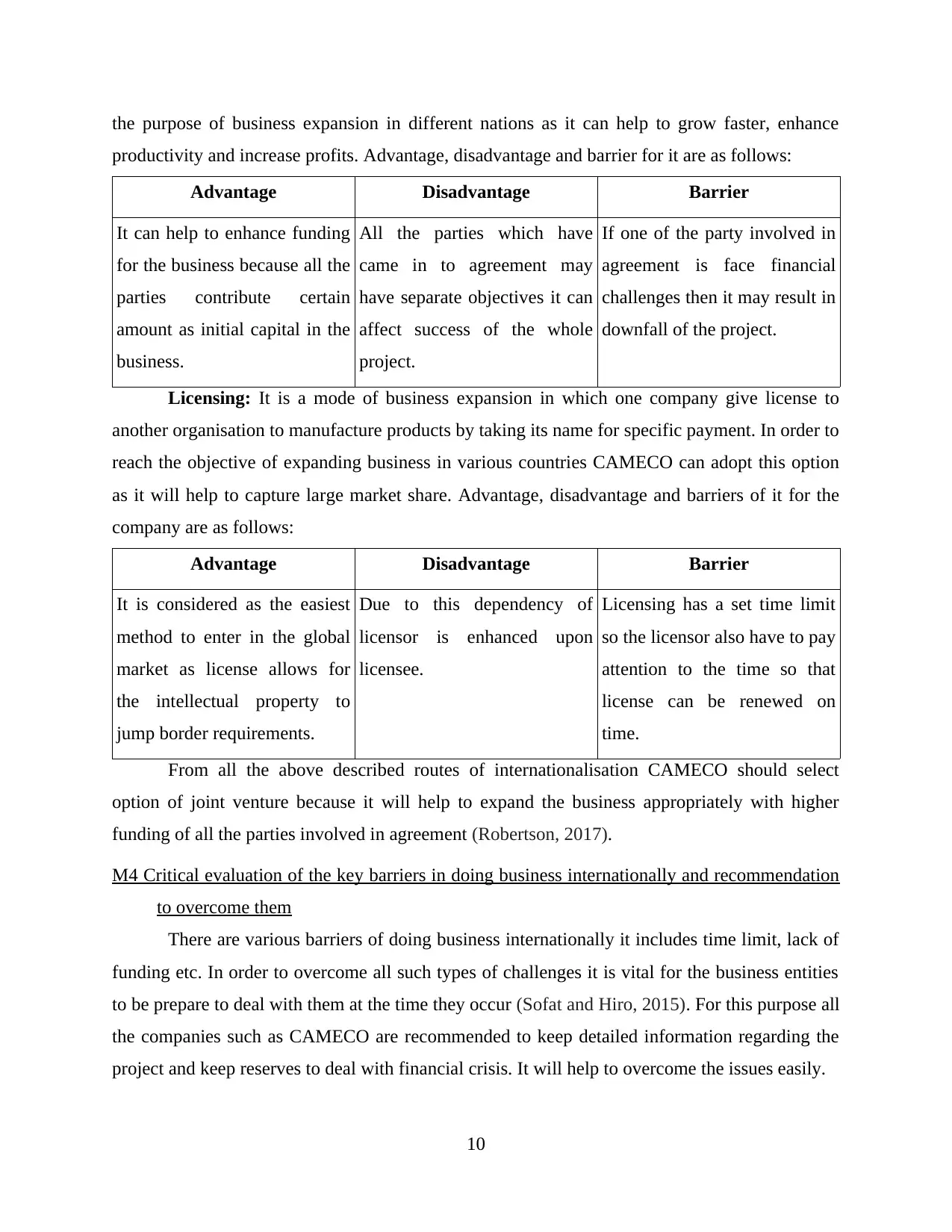
the purpose of business expansion in different nations as it can help to grow faster, enhance
productivity and increase profits. Advantage, disadvantage and barrier for it are as follows:
Advantage Disadvantage Barrier
It can help to enhance funding
for the business because all the
parties contribute certain
amount as initial capital in the
business.
All the parties which have
came in to agreement may
have separate objectives it can
affect success of the whole
project.
If one of the party involved in
agreement is face financial
challenges then it may result in
downfall of the project.
Licensing: It is a mode of business expansion in which one company give license to
another organisation to manufacture products by taking its name for specific payment. In order to
reach the objective of expanding business in various countries CAMECO can adopt this option
as it will help to capture large market share. Advantage, disadvantage and barriers of it for the
company are as follows:
Advantage Disadvantage Barrier
It is considered as the easiest
method to enter in the global
market as license allows for
the intellectual property to
jump border requirements.
Due to this dependency of
licensor is enhanced upon
licensee.
Licensing has a set time limit
so the licensor also have to pay
attention to the time so that
license can be renewed on
time.
From all the above described routes of internationalisation CAMECO should select
option of joint venture because it will help to expand the business appropriately with higher
funding of all the parties involved in agreement (Robertson, 2017).
M4 Critical evaluation of the key barriers in doing business internationally and recommendation
to overcome them
There are various barriers of doing business internationally it includes time limit, lack of
funding etc. In order to overcome all such types of challenges it is vital for the business entities
to be prepare to deal with them at the time they occur (Sofat and Hiro, 2015). For this purpose all
the companies such as CAMECO are recommended to keep detailed information regarding the
project and keep reserves to deal with financial crisis. It will help to overcome the issues easily.
10
productivity and increase profits. Advantage, disadvantage and barrier for it are as follows:
Advantage Disadvantage Barrier
It can help to enhance funding
for the business because all the
parties contribute certain
amount as initial capital in the
business.
All the parties which have
came in to agreement may
have separate objectives it can
affect success of the whole
project.
If one of the party involved in
agreement is face financial
challenges then it may result in
downfall of the project.
Licensing: It is a mode of business expansion in which one company give license to
another organisation to manufacture products by taking its name for specific payment. In order to
reach the objective of expanding business in various countries CAMECO can adopt this option
as it will help to capture large market share. Advantage, disadvantage and barriers of it for the
company are as follows:
Advantage Disadvantage Barrier
It is considered as the easiest
method to enter in the global
market as license allows for
the intellectual property to
jump border requirements.
Due to this dependency of
licensor is enhanced upon
licensee.
Licensing has a set time limit
so the licensor also have to pay
attention to the time so that
license can be renewed on
time.
From all the above described routes of internationalisation CAMECO should select
option of joint venture because it will help to expand the business appropriately with higher
funding of all the parties involved in agreement (Robertson, 2017).
M4 Critical evaluation of the key barriers in doing business internationally and recommendation
to overcome them
There are various barriers of doing business internationally it includes time limit, lack of
funding etc. In order to overcome all such types of challenges it is vital for the business entities
to be prepare to deal with them at the time they occur (Sofat and Hiro, 2015). For this purpose all
the companies such as CAMECO are recommended to keep detailed information regarding the
project and keep reserves to deal with financial crisis. It will help to overcome the issues easily.
10
⊘ This is a preview!⊘
Do you want full access?
Subscribe today to unlock all pages.

Trusted by 1+ million students worldwide
1 out of 14
Related Documents
Your All-in-One AI-Powered Toolkit for Academic Success.
+13062052269
info@desklib.com
Available 24*7 on WhatsApp / Email
![[object Object]](/_next/static/media/star-bottom.7253800d.svg)
Unlock your academic potential
Copyright © 2020–2025 A2Z Services. All Rights Reserved. Developed and managed by ZUCOL.




